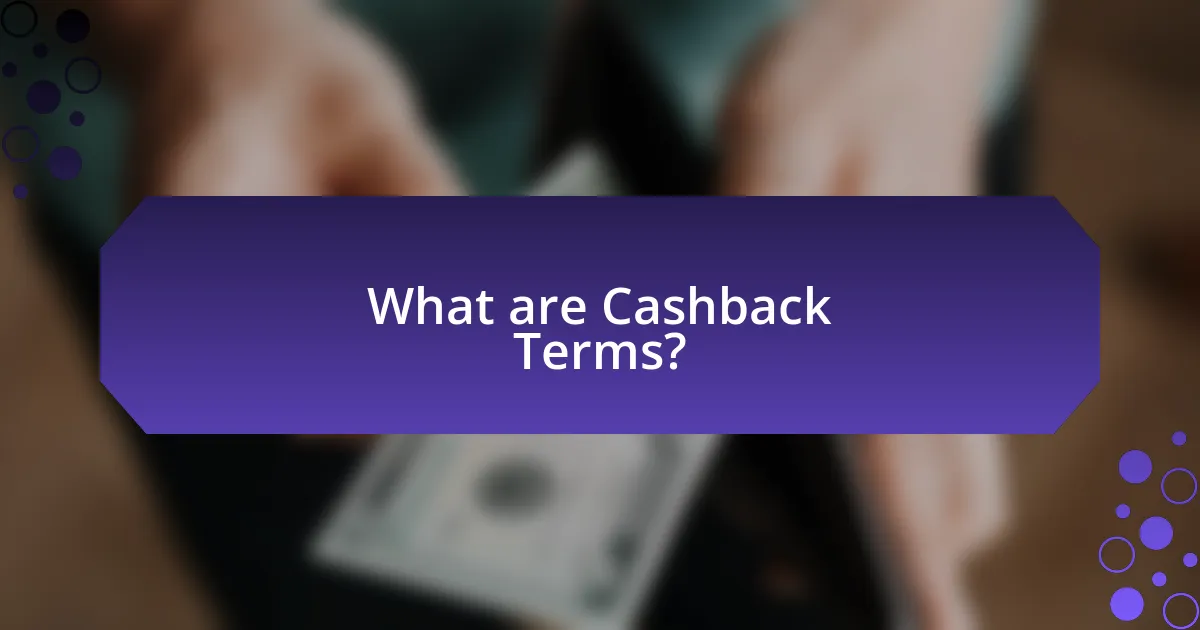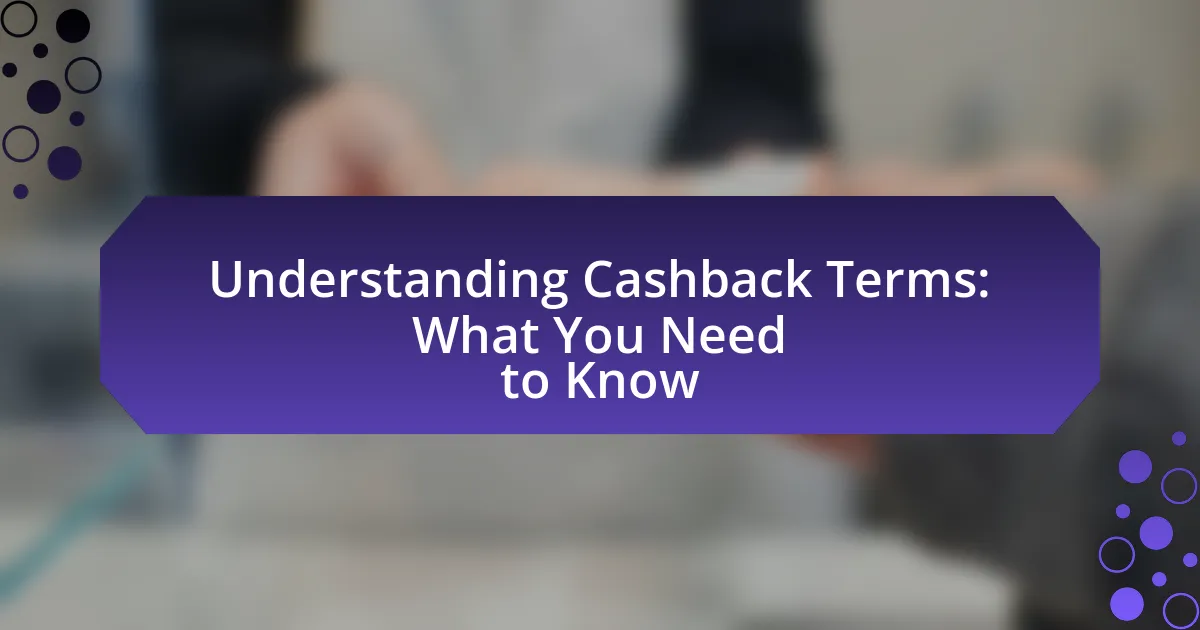Cashback terms are the specific conditions associated with cashback offers from retailers and financial institutions, detailing the percentage of purchases returned to customers, eligible products, and redemption processes. This article explores how cashback terms operate in various contexts, including credit cards and retail promotions, and highlights key components such as cashback percentages, eligible purchases, and limitations. It emphasizes the importance of understanding these terms for consumers to maximize their benefits and make informed financial decisions, while also addressing common pitfalls and best practices for utilizing cashback offers effectively.

What are Cashback Terms?
Cashback terms refer to the specific conditions and stipulations associated with cashback offers provided by retailers or financial institutions. These terms typically outline the percentage of the purchase amount that will be returned to the customer, the eligible products or services, the time frame for earning and redeeming cashback, and any limitations or exclusions that may apply. For example, a common cashback term might state that a customer earns 5% back on all purchases made within a promotional period, but only on select categories such as groceries or travel.
How do Cashback Terms work in different contexts?
Cashback terms function differently across various contexts, primarily in credit cards, retail promotions, and online shopping platforms. In credit cards, cashback typically refers to a percentage of the purchase amount returned to the cardholder, often ranging from 1% to 5%, depending on the category of spending, such as groceries or gas. Retail promotions may offer cashback as a rebate on specific products or during promotional periods, incentivizing purchases through limited-time offers. Online shopping platforms often provide cashback through partnerships with retailers, where users earn a percentage of their spending back when they shop through a designated link or app. These mechanisms are designed to encourage consumer spending while providing financial rewards, with the specifics varying based on the context and the terms set by the issuing entity or retailer.
What are the key components of Cashback Terms?
The key components of Cashback Terms include the cashback percentage, eligible purchases, redemption process, expiration dates, and any exclusions or limitations. Cashback percentage specifies the amount returned to the customer based on their spending, typically ranging from 1% to 5% or more. Eligible purchases define which transactions qualify for cashback, often excluding certain categories like gift cards or taxes. The redemption process outlines how customers can claim their cashback, whether through direct deposit, statement credit, or gift cards. Expiration dates indicate how long customers have to redeem their cashback before it becomes void. Lastly, exclusions or limitations detail any restrictions on earning or redeeming cashback, ensuring customers understand the full scope of the terms.
How do Cashback Terms vary between retailers and credit cards?
Cashback terms vary significantly between retailers and credit cards. Retailers often offer cashback as a percentage of the purchase price, which can be promotional or limited to specific products, while credit cards typically provide a fixed percentage on all purchases or specific categories, such as groceries or gas. For example, a retailer might offer 5% cashback on a limited-time sale, whereas a credit card could provide 1.5% cashback on every transaction. Additionally, credit cards may have caps on the total cashback earned or require a minimum spending threshold to qualify, which is less common with retailer cashback offers.
Why are Cashback Terms important for consumers?
Cashback terms are important for consumers because they outline the conditions under which cashback rewards can be earned and redeemed. These terms specify eligibility criteria, such as minimum purchase amounts, qualifying products, and time limits for claiming rewards. Understanding these details helps consumers make informed purchasing decisions and maximize their benefits. For instance, a study by the National Retail Federation found that 79% of consumers consider cashback offers when making purchases, highlighting the significance of clear cashback terms in influencing buying behavior.
What benefits do Cashback Terms provide to shoppers?
Cashback terms provide shoppers with financial incentives by allowing them to earn a percentage of their purchases back as cash rewards. This mechanism encourages consumer spending, as shoppers can effectively reduce their overall expenses through accumulated cashback. For instance, many cashback programs offer rates ranging from 1% to 5% on eligible purchases, which can lead to significant savings over time. Additionally, cashback terms often include promotional offers that can enhance the rewards during specific periods, further benefiting shoppers.
How can understanding Cashback Terms lead to better financial decisions?
Understanding cashback terms enables consumers to make informed financial decisions by clarifying how rewards are earned and redeemed. When individuals comprehend the specific conditions, such as eligible purchases, redemption limits, and expiration dates, they can strategically choose spending methods that maximize their cashback benefits. For instance, a study by the Consumer Financial Protection Bureau found that consumers who actively engage with their financial products, including cashback programs, tend to save more and incur less debt. This understanding allows consumers to avoid pitfalls like overspending to reach cashback thresholds, ultimately leading to more effective budgeting and enhanced savings.

What should you consider when evaluating Cashback Offers?
When evaluating cashback offers, consider the percentage of cashback, the categories eligible for cashback, and any limitations or exclusions. The cashback percentage directly impacts the amount you receive back on purchases, with typical rates ranging from 1% to 5% or more depending on the retailer or category. Additionally, some offers may only apply to specific categories, such as groceries or travel, which can affect your overall savings. Furthermore, be aware of any caps on cashback amounts or expiration dates that could limit your benefits. Understanding these factors ensures you maximize your cashback rewards effectively.
How do different Cashback percentages impact your savings?
Different cashback percentages directly influence the amount of money you save on purchases. For instance, a cashback rate of 5% on a $100 purchase yields $5 in savings, while a 1% rate results in only $1. This demonstrates that higher cashback percentages lead to greater savings on the same expenditure. According to a study by the Consumer Financial Protection Bureau, consumers who utilize cashback rewards effectively can save hundreds of dollars annually, depending on their spending habits and the cashback rates offered by their credit cards or programs. Thus, the percentage of cashback significantly affects overall savings, making it a crucial factor in financial decision-making.
What are the typical Cashback rates offered by various programs?
Typical cashback rates offered by various programs range from 1% to 10%. For instance, credit card cashback programs often provide 1% on all purchases, with higher rates of 2% to 5% on specific categories like groceries or gas. Retail cashback websites frequently offer 2% to 10% cashback on purchases made through their links, depending on the retailer. Additionally, some loyalty programs may provide cashback rates of up to 20% during promotional periods. These rates can vary significantly based on the program and the type of purchase, reflecting the competitive nature of cashback offerings in the market.
How can you maximize your Cashback earnings?
To maximize your cashback earnings, utilize cashback credit cards that offer higher percentages for specific categories like groceries, gas, or dining. Research shows that consumers can earn up to 5% cashback in these categories, compared to the standard 1% on other purchases. Additionally, take advantage of promotional offers and sign-up bonuses, which can significantly boost initial earnings. For instance, some cards provide a bonus of $150 after spending a certain amount within the first three months. Regularly review and adjust your spending habits to align with the categories that yield the highest cashback rates, ensuring you consistently earn the maximum possible rewards.
What restrictions or limitations should you be aware of?
Cashback programs often have restrictions and limitations that consumers should be aware of, including minimum purchase amounts, specific categories of eligible purchases, and expiration dates for cashback rewards. For example, many cashback offers require a minimum spend of $25 to qualify for rewards, and certain categories, such as groceries or travel, may not earn cashback at all. Additionally, cashback rewards may expire after a set period, such as 12 months from the date of earning, which can lead to forfeiture if not redeemed in time. Understanding these limitations is crucial for maximizing the benefits of cashback programs.
What are common exclusions in Cashback Terms?
Common exclusions in Cashback Terms typically include purchases made on gift cards, certain promotional items, and transactions involving taxes or shipping fees. These exclusions are often specified to prevent abuse of cashback offers and to ensure that the cashback program remains financially viable for the issuer. For example, many cashback programs explicitly state that purchases made with promotional discounts or during special sales events may not qualify for cashback rewards.
How do spending thresholds affect Cashback eligibility?
Spending thresholds directly determine Cashback eligibility by establishing the minimum amount a consumer must spend to qualify for cashback rewards. For instance, a credit card may require a minimum spend of $500 within a billing cycle to earn 1% cashback. If the consumer does not meet this threshold, they will not receive any cashback for that period. This structure incentivizes higher spending, as consumers are motivated to reach or exceed the specified threshold to benefit from cashback rewards.

How can you effectively use Cashback Terms to your advantage?
To effectively use cashback terms to your advantage, you should thoroughly read and understand the specific conditions associated with each cashback offer. This includes knowing the percentage of cashback, eligible purchases, and any limitations such as expiration dates or minimum spending requirements. For instance, many credit cards offer 1% to 5% cashback on certain categories like groceries or gas, but may have restrictions on how much cashback can be earned in a given period. By aligning your spending habits with these categories and maximizing your purchases within the terms, you can significantly increase your cashback rewards. Additionally, tracking your cashback earnings and being aware of promotional periods can further enhance your benefits, as some programs offer increased rates during specific times.
What strategies can enhance your Cashback experience?
To enhance your Cashback experience, utilize multiple cashback credit cards strategically. By doing so, you can maximize rewards on different spending categories, such as groceries, gas, or dining, which often offer higher cashback rates. For instance, some cards provide 5% cashback on specific categories that rotate quarterly, allowing you to optimize your earnings based on your spending habits. Additionally, combining cashback offers with promotional sales or discounts can further increase your total cashback. Research indicates that consumers who actively track and manage their cashback rewards can earn significantly more, with some reports showing an increase of up to 20% in cashback earnings when using multiple cards effectively.
How can you combine different Cashback offers for maximum benefit?
To combine different cashback offers for maximum benefit, strategically stack offers from various sources such as credit cards, retailer promotions, and cashback websites. For instance, using a credit card that provides 5% cashback on groceries while shopping at a store offering an additional 2% cashback can yield a total of 7% cashback on your purchase. Additionally, utilizing cashback websites that provide rebates on purchases made through their links can further enhance your total cashback. This method is validated by the fact that many consumers report maximizing their savings by layering multiple cashback opportunities, effectively increasing their overall returns on spending.
What tools or apps can help track your Cashback rewards?
Several tools and apps can help track your cashback rewards, including Rakuten, Ibotta, and Honey. Rakuten allows users to earn cashback from various retailers and provides a dashboard to monitor earnings. Ibotta offers cashback on grocery purchases and tracks rewards through its app, which also features offers and rebates. Honey, primarily a coupon extension, also tracks cashback from various online purchases and alerts users to available deals. These platforms are widely recognized for their effectiveness in managing and maximizing cashback rewards.
What are the common pitfalls to avoid with Cashback Terms?
Common pitfalls to avoid with cashback terms include overlooking expiration dates, failing to read the fine print, and misunderstanding qualifying purchases. Expiration dates can limit the time frame in which cashback can be claimed, leading to missed opportunities. The fine print often contains crucial details about restrictions or conditions that must be met to receive cashback, which can result in disqualification if ignored. Additionally, consumers may mistakenly believe that all purchases qualify for cashback, when in fact, certain categories or items may be excluded, leading to disappointment.
How can misunderstanding Cashback Terms lead to lost rewards?
Misunderstanding cashback terms can lead to lost rewards by causing consumers to miss out on eligible purchases or fail to meet specific conditions required to earn cashback. For instance, if a customer misinterprets the qualifying categories or the time frame for cashback offers, they may make purchases that do not qualify, resulting in no rewards being earned. According to a survey by CreditCards.com, 30% of consumers reported confusion regarding cashback terms, which directly correlates with their inability to maximize rewards. This highlights the importance of thoroughly understanding the terms to ensure that all eligible transactions are accounted for and rewards are not forfeited.
What are the risks of relying too heavily on Cashback offers?
Relying too heavily on cashback offers can lead to financial mismanagement and overspending. Consumers may prioritize purchases based on cashback incentives rather than actual needs, resulting in unnecessary expenses. A study by the National Bureau of Economic Research found that consumers often increase their spending by 20% when incentivized by cashback offers, which can lead to debt accumulation. Additionally, cashback programs may have hidden terms and conditions that limit the benefits, such as expiration dates or minimum spending requirements, further complicating the financial landscape for users.
What are some best practices for utilizing Cashback Terms?
To effectively utilize cashback terms, consumers should first read and understand the specific terms and conditions associated with each cashback offer. This includes knowing the percentage of cashback, eligible purchases, and any limitations or expiration dates. For instance, many credit cards offer 1% to 5% cashback on certain categories, and understanding these categories can maximize savings. Additionally, consumers should track their cashback earnings and ensure they meet any minimum thresholds for redemption, as some programs require a specific amount before cashback can be claimed. By being aware of these details, consumers can optimize their cashback rewards and avoid missing out on potential savings.



